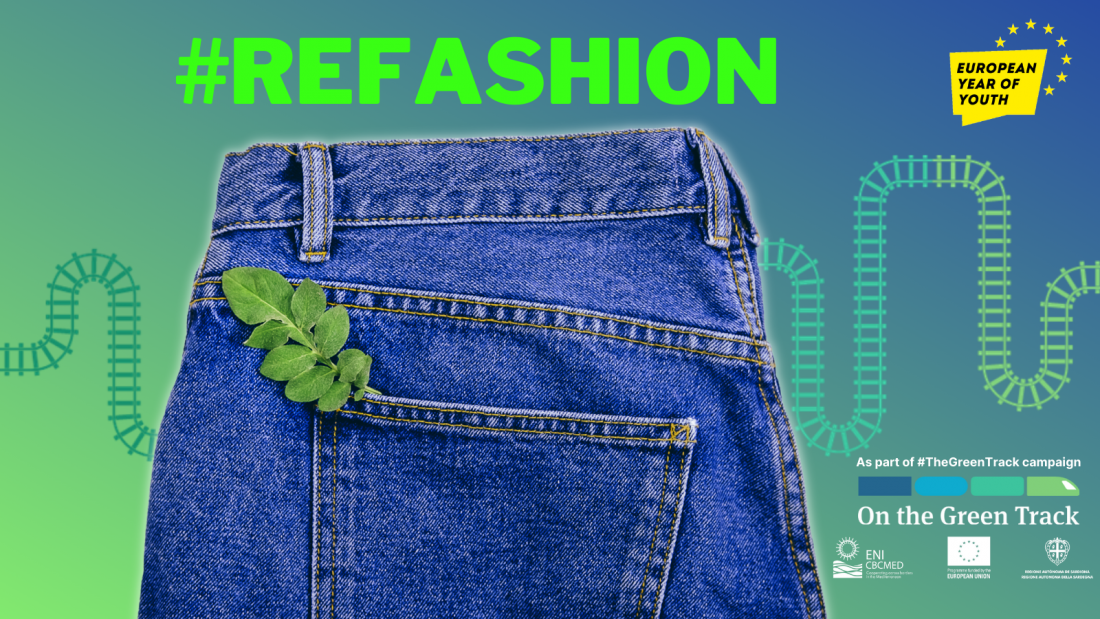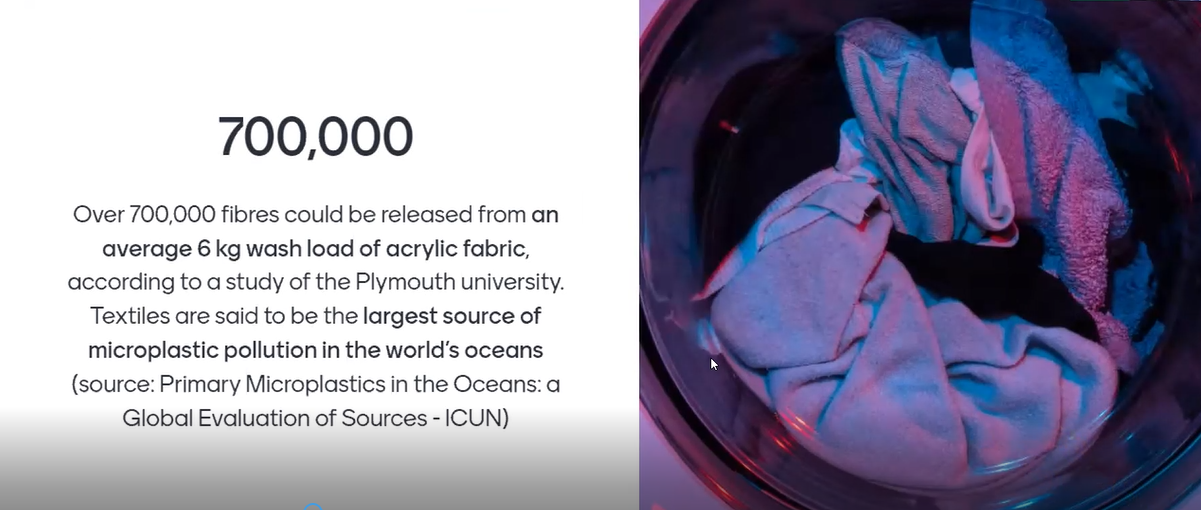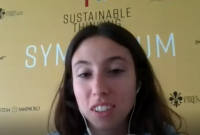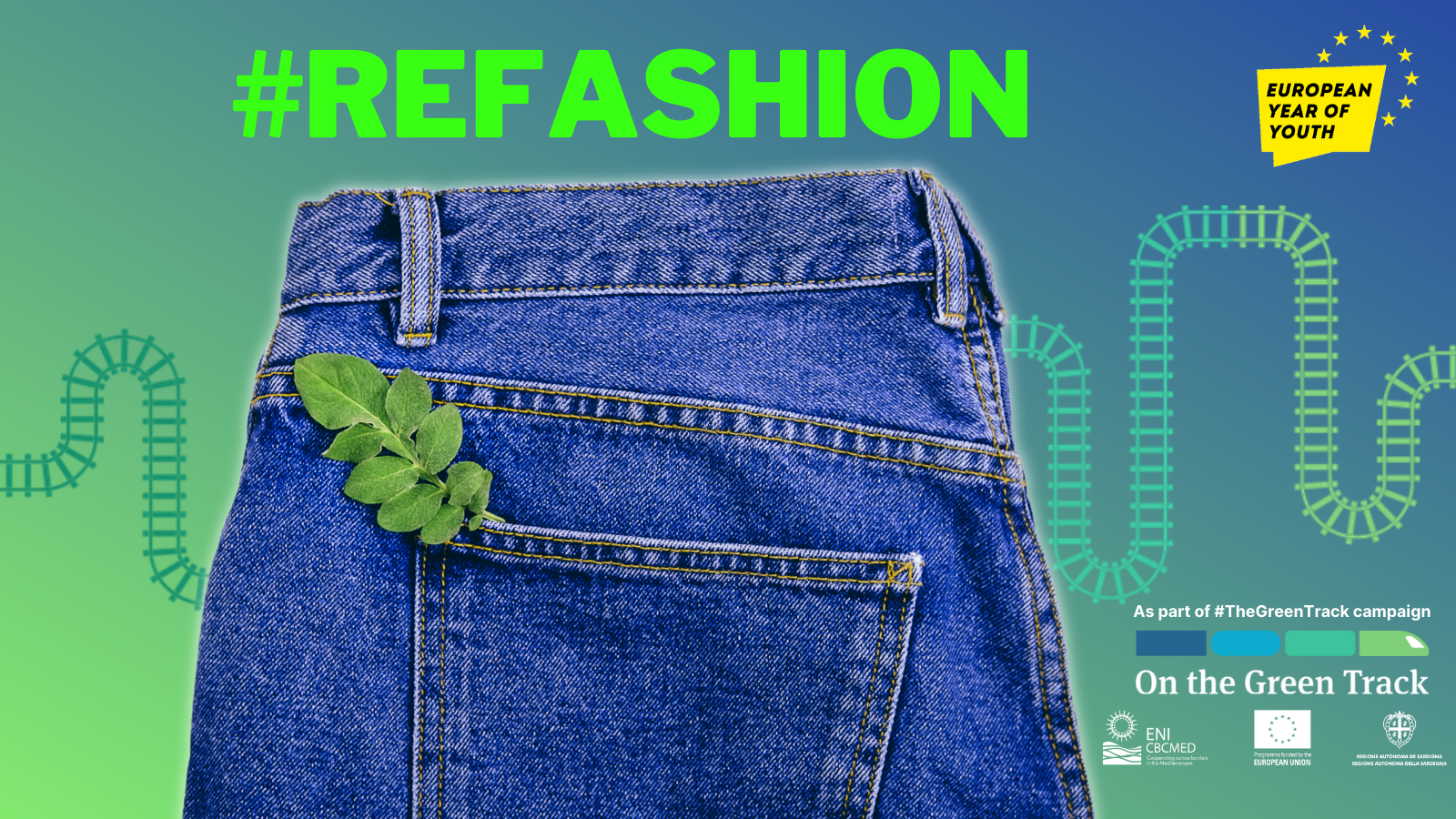Young Mediterranean people committed to a greener and more social fashion industry

Everyone heard of the collapse of the Rana Plaza in Bangladesh on 24th April 2013, in which over 1,000 people died and more than 2,500 were injured. This tragedy shook the world, and it was probably a turning point towards more awareness regarding the backstage of the fashion industry. When we mention the word “sustainability”, we should not only think of the environment but also its social aspect, not only consumers’ responsibility but also producers’ one.
As part of the European Union’s #TheGreenTrack campaign and in the context of the European Year of Youth, the ENI CBC Med Programme organised an online event on the 18th May 2022 attended by over 100 participants. This event was designed to be a platform to showcase initiatives and actions from a wide range of actors - Mediterranean young designers, activists, the fashion industry and the European Commission – bringing together different points of view in one single event.
Before summing up the main ideas and initiatives that have been presented, let us refresh and remind some key concepts. What is fast fashion? What is the difference between upcycling and recycling in the textile sector? We started our event with a quiz to learn more about the environmental toll of this very polluting industry. Fast fashion is its main symbol. Fast fashion consists of changing the trends continuously in a way that consumers do not stop buying. This leads to produce huge amounts of low-quality, low-cost clothes that in most cases end up burnt or in landfills.

What can be done to address this situation? Upcycling is one option, which consists of reusing old clothes and turn them into new products. While recycling textile means recovering the fiber, yarn or fabric and reprocess the textile material into useful products.
Towards a more environmentally friendly fashion: the industry takes action
Silvia Airaghi, who works for the Italian luxury brand ‘Salvatore Ferragamo’, explained that the group started its sustainability journey back in 2014. At the beginning, they tackled it from the angle of risk management, ensuring compliance with laws and regulations and as a competitive advantage. Then, they decided to focus more on the products themselves and the people.
In 2019, the Fashion Pact was created, a coalition of over 250 brands signed a collective commitment toward reducing their environmental impact through addressing 3 pillars: climate, oceans and biodiversity. Knowing that these brands represent one third of the global fashion industry (including fast fashion brands, sportwear, luxury, etc.), Silvia Airaghi confirmed that working together has much more advantage than competing against each other.

“Joint actions are way more powerful than individual actions and the Fashion Pact is a good example to demonstrate it.”
Young Mediterranean designers working for a more sustainable fashion: spotlight their initiatives
Hadeer Shalaby, co-founder of Green Fashion Egypt, presented her social enterprise which started in 2018. Together with her team, they focus on re-using off-cuts from textile factories and turn them into new fashionable pieces of clothes while supporting vulnerable women. So far, they have supported around 50 women by providing them a job in a safe environment. They also introduced other aspects such as the use of biodegradable tints and fibres.
Screenshot from Green Fashion Egypt Instagram account
Mejda Khaled is the young Tunisian behind Agaruw (‘ocean’ in Amazigh language), an online marketplace where they transform waste into eco-friendly fashionable products. They mainly work on customizing products and on recycling plastic waste by using new technologies such as 3D printing. They also created the “Mawj Lab” (‘Mawj’ means wave in Arabic) to support artists, artisans and designers. At the beginning, consumers were not 100% convinced by upcycled and recycled garments but now she can notice some changes in their habits and some of them even bring their old clothes to refresh the and
get more engaged towards sustainable fashion.
Screenshot from Agaruw Instagram account
Vérabuccia: turning pineapple peel into fashionable bags
In 2017, Francesca Nori realised that 50 % of the pineapple was wasted and thought: why not turning fruit peel into a natural product that can be converted into a bag or other accessories for the fashion industry? She patented the idea in Italy and registered the brand “Vérabuccia” (‘real peel’ in Italian) in 2020. Now, they are developing the prototype and start to market it. Together with the co-founder, Fabrizio Moiani, they really want to make their product known and promote a natural, cruelty-free material because touching it feels like like reptile leather but it is totally natural and eco-friendly.
Screenshot from Vérabuccia Instagram account
Feyrouz Hatoum and Céline Majdalany are two young Lebanese women working for La Boutique Sociale, a social enterprise developed by the NGO “arcenciel” back in 2002. Through this shop, second-hand clothes are valued, upcycled and sold at a symbolic price. This makes the shopping experience accessible to all, especially those in need. Moreover, they offer sewing trainings to women empowering them. They have some collecting points all over Lebanon and are planning to expand their work by creating pop-up stores and an online shop to reach more people. They would also like to start recycling clothes. Beyond the social aspect, they also want to raise awareness about the value of second-hand clothes and try to reduce clothes waste.
Who Made My Clothes: focusing on the fashion industry’s workers
Rania Rafie, country coordinator for Fashion Revolution in Egypt, explained what does this movement do in order to raise awareness of consumers, make them change their habits, inform them about citizens’ rights and safety conditions of workers in the textile industry. She also talked about some activities organised to spread the concept of sustainable fashion through webinars in the Middle East and North Africa (MENA) region and support local designers.
Developing a Mediterranean fashion identity
Luz Villalta, from the Textile Industry Confederation of Spain (Texfor), worked with other partners from TEX-MED ALLIANCES project on concepts that characterize the Mediterranean identity such as the importance of craftmanship, traditions, simplicity and developed a brand and platform where any Mediterranean brand, retailer, designer from the textile sector can join, respecting a series of values and principles that are included in their Manifesto. That is how THEMEDNEW was born. Among the principles that members have to agree on are hospitality and solidarity, inclusive creativity, human lifestyle, social justice and sustainability.
Beyond the strong environmental and social component of this initiative, it also offers major benefits to creators and designers: networking opportunities, promotion of their products and support from experts of the sector.
Screenshot from THEMEDNEW website
We had the chance to listen to the testimony of one of the young Spanish designers who is part of THEMEDNEW: Julia García Escribà. Thinking about the Mediterranean climate, she develops clothes that adapt to the change of temperature of your body so you do not need many layers of clothing. This is based on a technology called ‘Phase Change Material’ used by NASA astronauts. She also advocates for genderless clothes to reduce textile waste.
Providing eco-solutions to reduce environmental impact of textile
María del Mar Blanes, engineer from the Research and Textile Institute of Spain (AITEX), presented one of the eco-laboratories developed in the framework of CRE@CTIVE project. This eco-lab located in Alcoy, Spain offers the access to new technologies to artists and SMEs to help them reduce their environmental impact, especially in the finishing phase of leather and textiles production. She explained some of the techniques used in the available machines: the micro nebulization machine for dyeing and finishing, the laser cutting machine, the ozone finishing machine, the knife coating and spray systems… Most of these machines do not require water or chemicals with significant savings on the use of natural resources.
The European Commission want to drive ‘fast fashion out of fashion’
Paola Migliorini, Deputy Head of Unit at the Directorate General for Environment at the European Commission presented the EU strategy for Sustainable and Circular Textiles (issued on 30 March 2022). Among the key highlights of this strategy are the design requirements for textiles under the Ecodesign for Sustainable Products Regulation, addressing microplastics from synthetic textiles, clearer information on textiles through the Digital Product Passport, tackling greenwashing and proposing extended Producer Responsibility. During the second half of 2022, the European Commission will launch the #RefashionNow campaign focusing specifically on the issue of fast fashion. She invited all participants and speakers to share their initiatives in the EU platform for circular economy.
Awareness, cooperation and use of new technologies: some ingredients for a greener fashion industry
The discussions demonstrated that whatever type of player of the fashion industry is concerned, what we need is more awareness about the negative impact of the textile sector on people’s lives and on the planet. Cooperating more and using available technologies can be powerful tools to make the fashion industry more sustainable. The event was closed with a poll that showed that 97 % of the attendees said that they became more aware about the environment impact of the fashion and clothing industries thanks to the event. And 90 % of them will pay more attention to the environmental and sustainability aspects before buying clothes.
We would like to thank all the speakers for their valuable contribution and European Commission’s Directorate General for Environment for selecting this event as part of the #TheGreenTrack campaign.
LEARN MORE
- Salvatore Ferragamo’s Responsible Passion by Silvia Airaghi, sustainibility specialist
- Vérabuccia by Francesca Nori and Fabrizio Moiani + videos 1 - 2
- Video presentation of La Boutique Sociale
- Fashion Revolution by Rania Rafie
- Testimonial of Júlia Garcia Escribà, owner of Júlia G. Escribà Atelier and member of THEMEDNEW
- CRE@CTIVE project by María del Mar Blanes
- EU strategy for sustainable and circular textiles by Paola Migliorini










